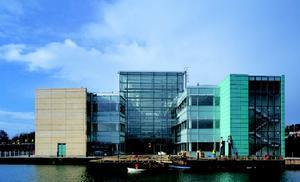On top of the natural ventilation that had proved so successful in Northampton¹, they specified precast concrete slabs carrying chilled water cooled using a lake. This bold services strategy won a thumbs-up from the client: Barclays Group Property Services.
Property Services is responsible for developing and managing all of Barclays buildings. It took a hands-on approach in this project, with Barclays' project director Gordon Harrison involved in concept design, and taking a close interest in the project throughout.
The client's input left architect Fitzroy Robinson in no doubt that flexibility was a watchword: it had to come up with a building that could be let or sold on the marketplace, suitable for a variety of uses. It had to allow partitioning and access for letting block-by-block and floor-by-floor. Different sized floor plates for the offices were non-negotiable, and there had to be scope for additional plant in case future occupants wanted it.
Fitzroy Robinson came up with a 10 000 m² office building split into two three-storey blocks, linked by a street-like atrium. The atrium runs east-west across the centre of the building, and forms the backbone of a pronounced axis dividing the site.
Architect Michael Winter explained that he was keen to promote the feeling of a single building – even though it may be used by different organisations. He wanted to safeguard the views across the atrium from one office to another, and draw people into the communal areas: the atrium and a square.
This building has to house 950 people – substantially less than the Northampton offices, which have 2500 occupants. Although smaller, it's still significant in Barclays' property portfolio: it is the group's only current new build project, and Harrison said it is "a reasonable chunk" of all new office space.
Harrison explained that Barclays employed the same designers because the Northampton project was so successful. As before, services engineer Troup Bywaters & Anders (TBA) worked closely with architect Fitzroy Robinson and contractor Tilbury Douglas.
Not only were the same companies involved, but – on the design side at least – most of the same people worked on both projects. Services engineer Peter Othen says the team learnt from its previous experience, and that teamwork was "one of the best features of the job".
The contract used was JCT 80, although architect Winter said it never had to be used. "This project was more like partnering than many 'partnered' projects," he said.
The Basildon building was essentially an evolution of the Northampton project, and anyone familiar with the earlier scheme will quickly be at home here. Although there was a written brief, it was loose enough to give the design team scope to be creative. A notable exception was the rigid stipulation of getting an 'excellent' rating under the BRE's Environmental Assessment Method (see 'Full BREEAM ahead').
"Not easy" was how Othen described achieving this rating. The most obvious evidence of BREEAM on site is the widespread planting: trees and shrubs adorn every conceivable spot. Even the standby generator is crowned with a planted roof. This underlines just how important environmental issues were for Barclays in this project. The group has a central policy statement on the environment, and Property Services naturally sings from the same hymn sheet.
Getting into the building
The building occupies a steeply sloping greenfield site on the eastern edge of Basildon in Essex. It is close to the A127, a fast double carriageway to the M25, and so offers good accessibility by car.
However, the approach road is already congested at peak hours. The site is also awkward to get to by public transport, being too far to walk to from Basildon railway station.
Permanent employees will park and approach from the north, to be struck by the bright blue copper cladding used on this facade. Visitors, meanwhile, approach the building from the south, and are greeted by a large lake – used primarily to help cool the building. Surface water runs from landscaped areas into this lake, which is encircled by an attractive wooden boardwalk.
Visitors' view of the building is a stark contrast to the blue cladding on the north side: the south facade wears a more sober, heavy stonework. This more traditional, 'bank-like' cladding is used to add thermal mass and cut solar gains, which is not important for the north facade. The heavy stone is accompanied by deep recesses for windows and fixed solar shading.
The shading was designed to prevent all direct sunlight from entering in summer, while some solar gains will be allowed in beneath the brise soleils during winter or mid-season – when the heat is beneficial.
It is a well insulated building, and the roof has an impressive U-value of less than 0·25 W/m²K. Walls, meanwhile, are designed to be lower than 0·45 W/m²K, and the glass is rated at 3·3 W/m²K.
Although there is double glazing on the atrium and windows, the architect did not use low emissivity glass. This means that solar gains in summer, and heat losses in winter, are higher than they could have been.
Six modular plantrooms are located on the roof and, like the north facade, they are clad in a bold blue copper.
What's inside?
Visitors to Barclays' building are welcomed into the bright, airy atrium that runs the length of the building. Apart from glass screens running along the street on the ground floor, there are no partitions. This gives visitors a clear view from all levels across the street and through the windows on the opposite side of the building. However, this could change once the building is let, because a quarter of the floor space offers the option of installing cellular offices.
Visitors who venture into the office areas are treated to attractive exposed soffits, painted white, which give an uncluttered feel. The soffits have curved coffers to maximise the ceiling surface area – which brings the extra bonus of attractive surrounds for luminaires.
A high floor to ceiling height of 3350 mm adds to the impression of airiness, and ensures daylight penetrates deep into the offices. However, the architect explained that this too could change post-letting, as the design allows suspended ceilings to be fitted.
The spacious basement is likely to be fitted out as a dining area and kitchen. The space currently earmarked as a dining room affords a good view over the lake, and access onto the wooden boardwalk.
Power to individuals
The six rooftop plantrooms each serve three zones – 18 in total – measuring from 400 to 540 m². Each zone has local controls and its own supply of services from a plantroom.
The plantrooms all contain very similar equipment: an air handling unit, two or three boilers, a calorifier, toilet extract unit, and a Carrier chiller. Standardising plantroom equipment is good news for maintenance and replacing components if they wear out.
Natural ventilation is a critical part of the design, and TBA aimed to provide considerable air movement and fresh air (at least 12 l/s per person). There are 390 cm² of trickle vents for every 9 m² bay – half under occupant control and half permanently open.
The roof of the atrium protrudes above the rest of the building, forming a reservoir to draw up warm, stale air. Two vents are positioned on each side of the atrium: one on the north facade and one on the south.
Only one of the vents opens at a time, controlled by pressure sensors outside the building (figure 1). These work in tandem with thermostats in the atrium to ensure that warm air leaves through whichever side of the building has lowest air pressure.
Othen explained that the lee side of the building isn't necessarily the side with lowest pressure. In fact modelling revealed that pressure on the lee side may be higher than that inside the atrium. Why? Because wind can blow over the building, creating turbulence that actually raises air pressure at high level near the air outlets.
To prevent cold air defeating the ventilation strategy and entering in this way, detectors have been fitted to shut the vents and eliminate cold down-draughts.
In addition to the high level vents, a lower set of windows automatically opens in extreme conditions. This second set allows for much higher ventilation rates, and may also be used for smoke clearance if there is a fire.
As well as the natural ventilation, to ensure a minimum air change rate, the plantrooms' air handlers power air into the building through imposing blue pipework. A total of 32 steel tubes pierce down through the roof and run the full height of the atrium.
These 500 mm diameter pipes feed floor voids on each level of offices. They are divided in two ducts internally, so each one has two inlets and serves two floors. This strategy safeguarded the independent control for each floor without cluttering up the clean lines of the atrium with ductwork. The pipes had to be tailor-made for the building by one of Tilbury Douglas' overseas suppliers. Othen said that they were originally intended for use in an oil rig that was never built. As a result, they are super-heavy duty: the 8 mm thick steel casing could carry a small tornado.
Occupants have more control over ventilation in this building than in more conventional offices. Not only do they have independent control over the plant operating in their zone, but they may also shape conditions more directly by opening windows or the controllable trickle vents. The powered window openings can be controlled precisely, although where necessary the building manager can override occupant preferences using the bems.
Thus the building manager is the ultimate arbiter of air change rates and able to protect energy efficiency against attrition by individuals. Of course, the building manager enlists the help of the bems, which in this building can control windows and trickle vents to reap the benefits of night cooling.
What about temperature?
The designers and client had an enlightened attitude to design temperatures for the offices. No signs here of the 22º±1ºC that is so pervasive in traditional speculative offices. Instead, the team agreed on a range from 21-25ºC, with an acceptable upward drift within this range over the course of the day.
As ever in an office building, cooling is more challenging than heating. Like Northampton, this building has a staged sequence of cooling strategies. Initially, when ambient temperatures are between 16ºC and 21ºC, the mechanical and natural ventilation cools the building simply by bringing in cool air.
When ambient temperatures rise above 21ºC, the lion's share of the cooling load is taken up by the lake. In a commendable show of foresight, the designers sized the lake to cater for the Phase 2 extension: it has a capacity of 8000 m³.
Water is drawn from the northern end of the lake at a depth of 2 m. This primary cooling water enters the building through the basement, where it is pumped through two sizes of mesh filters and pushed through one of two titanium plate heat exchangers.
On the other side of the cooling circuit, the so-called 'natural cooling loop' feeds a secondary water loop up to the plantrooms. From here small booster pumps send it out to cool the exposed concrete slabs (see factfile 'Cooling from on high').
Water is only pumped into the slabs during charging periods: like a kind of slow-response radiator, the pumps will cut out when the concrete floor slabs reach the desired temperature. Chilled water enters the office floor slabs on each level, to cool the exposed soffit of the floor below .
The technique is a distant cousin of underfloor heating: 110 m snake of polybutylene tubing with a diameter of 20 mm is embedded in the soffit. This tubing was set in 3 x 7·5 m precast concrete slabs, made off-site before building started².
When the lake water temperature rises above 13ºC, and so is unable to cool the slabs sufficiently, the chillers take up the weight. The chillers now use the lake as a condenser – still feeding the slabs with water at 13ºC.
If resultant air temperatures rise above 25ºC, each chiller has an extra 70 kW on tap to cool the air supplied through the ahus. The chillers may also be used to dehumidify the building when the dewpoint temperature peeps up above 16ºC.
When this happens, an adjustable setpoint on the chillers is brought down to the 6ºC needed for effective dehumidification. A mixing valve ensures that water destined for the slab does not stray from 13ºC.
Turning to the heating side of the equation, two or three Potterton boilers in each plantroom work in parallel to heat their respective zones. These 100 kW atmospheric units are 85% efficient, and have low NOx emissions. Condensing boilers were not specified because the heating requirement is so low – mainly for early morning preheating.
There is underfloor heating in most of the atrium's ground floor. Meanwhile, in the offices, a weather-compensating network of Merriott radiators is strung around the perimeter of the building.
There is a clever system used to stop air destined to leave the building through the trickle vents from being heated. The bems is able to cut off the perimeter heating on the lee side of the building, so that in strong winds air leaving the building is not heated needlessly.
Making light work of it
Light for the offices comes from luminaires with two 40 W compact fluorescent lamps. These will be controlled to maintain 350 lux, and have an efficiency of 2·2 W/m²/100 lux at the peak 500 lux.
Uplighters throw light on the roof of the atrium, which is mostly opaque glass and so reflects light back down into the building. Metal halide light sources also light the street floor directly, providing 50 lux at floor level. Limited decorative lighting of the ventilation pipes comes from 35 W tungsten halogen lamps submerged in the floor.
Externally, light will escape through the glass at night – making the building appear to glow. On top of this another 20 lux illuminates the exterior. There is also floodlighting to the south-east corner of the building, controlled by dusk-to-dawn photocells linked to the Trend building energy management system.
While there is minimal feature lighting around the entrance, cable runs are available for additional external lighting should the tenant require it – the flexibility theme even extends outside the building.
Power protection
High voltage electrical power from Eastern Electricity serves two 1250 kVA transformers in the basement, each feeding two low voltage switchboards. Should one of the transformers fail it is possible to operate a switchboard individually – supported by the remaining transformer.
If the electrical supply goes really pear-shaped and power fails completely, there are two 1000 kVA low voltage generators near the north perimeter of the site. These units fire up together initially to support the electrical load, although one may cut out if it is not needed when the load has stabilised.
Small power and light distribution for the offices comes from six 250 A rising busbars. These send power through an underfloor system of recessed floor boxes, spaced at 3 m centres, each with two twin sockets. Consultant TBA made an allowance of 25 W/m² for small power in the offices, with an extra 15 W/m² available for future expansion.
Dotting the I's
The building will be completed on its £20 million budget and it has, in Othen's own words, been "very closely managed". This attention to costs, and the emphasis on teamwork, have been pervasive themes throughout the project, not just from the client, but from contractors too.
However, the project has not been entirely without a hitch. The plantrooms were prefabricated off-site by Dutch company Gibros and were craned into position, saving a lot of programme time. Despite arriving in immaculate condition, though, they looked a little rough around the edges on the day of our visit.
The plantrooms had to be clad in copper on-site to ensure a good colour match, and the cladding contractor looks to have been a touch over-zealous in its work. A word of caution here for others who favour prefabricated plantrooms: factory-perfect equipment installed midway through a project may lose its sparkle by handover.
TBA did not have space in the original contract for post-completion monitoring to tweak the cooling and ventilation systems. However, Othen said he hopes for an opportunity to revisit the building, once occupied, sometime next year.
Will it be a treat for people working in the building? Certainly, they'll be greeted by a comfortable environment – lots of fresh air, and cool heads. They'll also find themselves in a landmark building alongside Basildon's otherwise unremarkable townscape.
However, the building's environmental bona fides – now glowing – could easily be tarnished by a tenant that is not sympathetic to low energy ideals. How easy (and how frustrating for the designers) for the occupier to install suspended ceilings and fan coils. You wonder if the flexibility card was played just a little too ardently.
Full BREEAM ahead
John Field, from Target Energy Services, carried out a Building Research Establishment Environmental Assessment (BREEAM) of Barclays’ new building. In his view: “It’s hard to see how the design team could have done any better on this site.” It scored 36 credits out of a maximum 42, only dropping credits in three areas:Cooling from on high
Barclays, Gloucester Business Park, Basildon
Form of contract: JCT 80
Contract period: 19 months Was National Engineering
Specification used: Yes Noise levels
Offices: NR 35
Toilets and circulation: NR 40
Occupancy: 7 mm²/person External design conditions
Winter: -4ºC
Summer (non a/c): 29ºC db, 20ºC wb Structural details
Clear floor void: 300 mm
Floor to ceiling: 3350 mm Internal design conditions
21-25ºC resultant temperature U-Values (W/m²K)
Walls: <0·45
Roof: <0·25
Glazing: <3·3 Loads
Heating load: 1 MW (calc.) 1·2 MW (installed)
Cooling load: 500 MW (calc.) 550 MW (installed)
Fan power: 1·0-2·0 W/m² (variable speed) Target energy use (gfa)
Gas: 45 kWh/m[sq]/y
Electricity: 41·8 kWh/m[sq]/y
Energy breakdown
Fans & pumps: 9·5 kWh/m[sq]/y
Chillers 5.3 kWh/m[sq]/y
Small power: 25 kWh/m[sq]/y
Lighting: 27 kWh/m[sq]/y
Pressure test: No
BREEAM: Yes
Rating: 36 (excellent) Ventilation
Supply air temperature: 17ºC
Room temperature: 25ºC
Fresh air: 100%, 12 l/s/person (min) Distribution circuits
LTHW: 82ºC flow, 71ºC return
DHWS: 60ºC flow, 55ºC return
Refrigerant: R407c Electrical supply
Two 1250 kVA transformers 2000 kVA standby power Lighting
Types: LG3 Category 2
Efficiency: 2·2 W/m²/100 lux
Lux levels: 350 adjustable to 500 (office), 50 (atrium) Lifts
Two 13 person lifts @ 1 m/s Costs (£ million)
Total cost: 20
Building services total: 6·4
Services cost (£/m[sq] nfa): 690 Services costs (£1000’s)
Sanitary appliances: 64
Cold water services: 57
Hot water services: 172
Heating services: 540
Cooling services: 1900
Ventilation: 96
Drainage (above ground): 58
External gas & water: 36
Preliminaries @ 8%: 220
Generators: 412
Meters & switchgear: 250
Lighting installation: 912
Power installation: 238
Controls package: 330
Fire detection & alarms: 125
Security: 166
Earthing & bonding: 13
Lifts: 130
MCCs: 243
Sundries (kitchen): 187
Preliminaries: 240
Source
Building Sustainable Design
Reference
¹Field J, 'Squaring two circles', Building Services Journal 4/97. ²Bunn R, 'Cold silence', Building Services Journal, 3/99.























